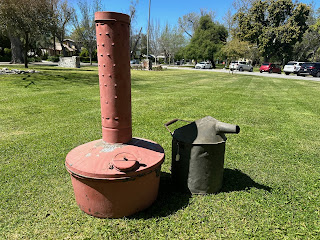A History of Claremont in 100 Objects: Orchard Heater-Mary Garner Hirsch Collection #5 "Orchard Heater/Smudge Pot"
Artifact Description: Red metallic cylinder approximately two feet in height with reservoir base and ventilated funnel stack.
Orchard Heaters, also called Smudge pots, were a common sight across Southern California for almost half a century. Considered mandatory equipment for citrus orchards during the winter season, they were used to prevent frosting of citrus during winter cold periods. Although the orchards that smudge pots kept warm are now mostly gone, the transformation and environmental changes they brought are still relevant to us today.
The smudge pot was invented by William Scheu in Grand Junction Colorado in 1907, who designed an oil-burning stack heater that would help to protect crops against frost that was more reliable than either coal burners or an open fire. Scheu moved to Upland, California where he founded a company that designed smudge pots for orchards. By 1920, Scheu had a company that distributed 30,000 heaters and had employed 50 people. smudge pots were in wide use during frost seasons in California throughout the 1920s and after the Second World War. The use of smudge pots declined as concerns about the thick smoke that they produced became more prominent.
The black tar was the result of the poor quality of fuel burned. Smudge pots burned thick tar heavy fuels that produced significant clouds of smoke that in some cases reduced visibility at ground level. Eventually, Scheu’s son, Willis, worked with the University of California to design a new model that would recirculate combustion products to prevent the formation of soot. These devices became the ancestor to modern-day space and patio heaters. The demand for space heaters declined in the post-war period as companies such as General Dynamics, Kaiser Steel and Aerojet in Pomona, Fontana and Azusa respectively began to offer new jobs that began to displace the citrus industry. As new manufacturing work began to appear, and as the demand for new housing swelled, California’s citrus plantations began to be redeveloped, further reducing the demand for smudge pots.
Gradually, legislation also began to pass that regulated the use of heaters and required permitting for their use. Smoke producing oil heaters were banned in 1957. In 1972, the State included orchard heaters to the regulatory frameworks of the California Clean Air Act, subject to the State Air Resources Board. Remaining orchards began to abandon oil heaters and instead switched to more efficient wind machines that protected crops by mixing colder and warmer air layers.
Smudge pots required extensive labor to maintain, fuel and light. Plantations in California, including the ones formerly in Claremont made use of migrant labor, and employed men, women, and children. These workers were typically discriminated against in other fields, and worked in orchards when no options were otherwise available. The burning of smudge pots exposed them to the smoke and environmental hazards that these devices produced, increasing their risk for lung disease and cancer. As the orchards gradually disappeared, so did many livelihoods, reshaping former communities.
Claremont Heritage’s Barrios Oral History documents the history of the people who lived in Claremont’s historic barrio neighborhoods. Many of the workers that worked in Claremont’s citrus groves lived in these communities. Robert Salazar, a resident of these neighborhoods interviewed for Claremont Heritage’s Barrios Project recalls his father’s difficult work in Claremont’s citrus orchards: “My dad held down two jobs for better than thirty years. And he worked at Kaiser Steel for maybe forty years. He used to get up at that freezing temperature. They used to go out there and light those big old incinerators, or what do you call them. My mom did work at the packing house here in Claremont, so they both worked a lot.” Kirsten Aase-Gonzalez, another resident of Claremont’s Barrios remembers her husband’s experience with these lighters and the affect that work had on him: “I know he worked in the groves and sometimes couldn’t come to school because he had been up all night smudging. But he wasn’t afraid of hard work.”
In addition to the social effects of citrus, the citrus industry in California brought dramatic economic development, but it also transformed the local environment and ecologies in ways that still affect our lives today. Citrus is not native to California; it is an introduced cultivar and although it has come to stand in for California just as much as the palm tree, it is part of a complex legacy of the ways in which we shape and define nature itself. Between the late 19th century and the early 20th century, citrus orchards were found in Riverside San Bernardino, Orange and Los Angeles Counties who all have shared a similar relationship to citrus fruit and products.
The citrus industry created extensive demand for fruit across the United States through extensive marketing and advertising campaigns. Citrus was presented as an essential part of the immune system and beneficial for daily functioning. Posters advertising citrus include imagery of athletes, boosted through the energy and vitality of citrus. This demand led to the creation of specialized railroad containers, and eventually an entire system for citrus distribution by railroad. Railroads themselves played an integral part in the creation of the citrus boom, owning much of the land where citrus orchards eventually would bloom. Advertising with slogans such as “Citrus for health, California for wealth” they would create a dream of wealth from the exotic fruit.
The dramatic expansion in citrus necessitated the clearing of land, the construction of new rail lines and irrigation systems that drew water for agriculture. These irrigation projects also worked hand-in-hand in establishing European and later American ownership of Californian lands, and dispossessed Native American peoples. A dramatic example of the full extent of these irrigation systems can be found in Riverside County at the Gage Canal in the Historic State Citrus Park. This canal, more than 11 miles long draws water from the Santa Ana River for more than 640 acres of orchards in San Bernadino County. Prado Dam in California is another example of how citrus altered the environment. The dam was built in 1941 in response to destructive floods in 1938 and to protect housing, farms and towns built in the former marshlands of Orange County. Today the Orange County Water District manages the dam and the ground water systems under Orange County, which were used to support the growing demand for water for citrus trees. Here in Claremont, the Pomona Water and Land Company purchased land from the Palomares estate that also included the Palomares Adobe, built by Ygnacio Palomares located on Park Avenue. The Pomona Land and Water Company used the land to divert water from San Antonio Creek and water from an Artesian well discovered by Francisco Palomares to feed the growth of citrus orchards in Pomona and in what would become Claremont.
Air pollution from the railroads, from trucks and farm equipment including the smudge pot, which released great amounts of smoke when used exposed farm laborers and residents to environmental contamination, and typically disproportionately affected non-white workers. The use of pesticides, most notably DDT resulted in significant pollution of groundwater and soil. When DDT was banned in the 1970s, many producers illegally dumped the waste into California’s water and oceans. The State of California continues to investigate the dumping and has delivered some of the largest penalties in environmental justice case history over the costs associated with environmental damages.
Ecologically, the Citrus industry also played a role the decline of one of California’s most important natural resources, the Oak Tree. There are five major species of Oak native to Southern California. The most common being the California Oak, Quercus californica. Oak trees, oak woodlands and oak savannahs once dominated California’s interior, but due to a combination of deforestation for grazing land, charcoal production, and simply urban expansion, many of these woodlands are now in decline or have vanished entirely. The citrus industry contributed to this decline through introducing diseases, including phytophthora. One variation, Phytophthora ramorum is responsible for Sudden Oak Death which increases the risk of forest fires and ecosystem collapse.

Quercus agrifolia, the Coast Live Oak was once a dominant force in California's ecological regimes. The species is not considered endangered as it continues to be used extensively for ornamentation purposes, but the once great oak forests that dotted across Southern California have since declined or vanished. This example can be found at Claremont's own California Botanical Gardens.
Although the citrus industry enabled the early population boom in Southern California, and gave rise to the early beginnings of modern Southern California today, the technology and labor required created injustices and environmental harms that linger today. California is however, also considered the birthplace of the modern environmental movement; John Muir founded the Sierra club because of the destructive use of placer mining and the destruction of California’s streams and water ways. The natural beauty and ecology of California encouraged many environmentalists and naturalists to campaign politically to defend and cultivate it. In closing this discussion, I ask us to consider the orchard heater and imagine it as part of a much larger system. What kind of system did it look like, and what did it cost? Can we build a better system today?
Acknowledgements
A History of Claremont in 100 Objects is a blog series presented by Claremont Heritage and written and contributed to by its members. Based on the podcast A History of the World in 100 objects by the BBC and the British Museum, presented by former British Museum director Neil MacGregor. A History of Claremont in 100 Objects explores Claremont history through its material cultural legacies, placing objects important to the history and development of Claremont in larger relation to US and World History.
About the author:
My name is Cooper Crane. I am an archival intern with Claremont Heritage. I study history and anthropology with an emphasis on archaeology and the history of empire and environmental history at Pomona College in Claremont. I was born in Anaheim and have lived my whole life in Corona California, a city with a similar shared history to Claremont. I have degrees in history, anthropology and political science from Norco College California and am a certified California Climate Steward through the University of California Department of Natural and Agricultural Resources. I write to explore history through the material objects of history, and by exploring the elements of history that are unwritten. My current work at Claremont Heritage includes the curation of artifacts on display at the Garner House and the Claremont Packing House, the creation of artifact descriptions for our archives and contributing to A History of Claremont in 100 Objects.
Citations:
Aase-Gonzalez, Kirstin. “Interview with Kristin Gonzalez.” Claremont Heritage Barrios Project. Chelsa Liu, Interviewer. May 12, 2023.
Anguiano, Dani. “High concentrations of DDT found across vast swath of California seafloor.” Mar. 24, 2023
Arellano, Gustabo. “The Santa Ana River Flood of 1938 Remains Orange County’s Worst Natural Disaster.” OC Weekly. Sep. 15, 2023.
Blackstock, Joe. “One man’s tinkering leads to protecting the Inland Empire’s citrus orchards.” in Daily Bulletin, July 3, 2023.
Crasweller, Ross. “Orchard Frost: Protection with Wind Machines.” PennState Extension. March 23, 2022.
Dickerson, Jennifer. “Citrus in the Orange Empire.” Feb. 17, 2023
Eyrich,Tess. “Exhibit reveals hidden histories behind California’s citrus industry.” UC Riverside News, Apr. 12, 2018
Landis, Mark. “Smudge pots in citrus orchards have long been a familiar sight in Southern California.” in The Sun. February 7th, 2022
“Pomona” in Pomona Velley Historical Collection. California Polytechnical University Pomona. accessed October 24th, 2023.
Salazar, Robert and Campos, Lorraine. “Interview with Robert Salazar and Lorraine Campos.” Claremont Heritage Barrios Project. Chelsa Liu, Interviewer. Apr. 28, 2023.
“Suden Oak Death: A Growing Epidemic.” Learn About the Park, National Parks Service, accessed Oct. 25, 2023.
“The Irrigation: Irrigation—The Gage Canal.” California Department of Parks and Recreation. accessed Oct. 25, 2023









Comments
Post a Comment